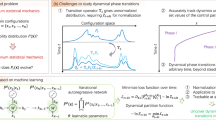Abstract
We define a class of dynamical maps on the quasi-local algebra of a quantum spin system, which are quantum analoges of probabilistic cellular automata. We develop criteria for such a system to be ergodic, i.e., to posses a unique invariant state. Intuitively, ergodicity obtains if the local transition operators exhibit sufficiently large disorder. The ergodicity criteria also imply bounds for the exponential decay of correlations in the unique invariant state. The main technical tool is a quantum version of oscillation norms, defined in the classical case as the sum over all sites of the variations of an observable with respect to local spin flips.
Similar content being viewed by others
References
C. Maes and S. B. Shlosman, Ergodicity of probabilistic cellular automata: A constructive criterion,Commun. Math. Phys. 135:233–251 (1991).
J. L. Lebowitz, C. Maes, and E. R. Speer, Statistical mechanics of probabilistic cellular automata,J. Stat. Phys. 59:117–170 (1990).
A. Georges and P. Le Doussal, From equilibrium spin models to probabilistic cellular automatata,J. Stat. Phys. 54:1011–1064 (1989).
T. M. Liggett,Interacting Particle Systems (Springer-Verlag, New York, 1985).
M. Fannes, B. Nachtergaele, and R. F. Werner, Finitely correlated states of quantum spin chains,Commun. Math. Phys. 144:443–490.
M. Fannes, B. Nachtergaele, and R. F. Werner, Finitely correlated pure states,J. Funct. Anal. 120:511–534 (1994).
S. Richter, Construction of states on two-dimensional lattices and quantum cellular automata, Ph.D. Thesis, Osnabrück (1994).
G. Grössing and A. Zeilinger, Quantum cellular automata,Complex Syst. 2:197–208, and 611–623 (1988).
S. Fussy, G. Grössing, H. Schwabl, and A. Scrinzi, Nonlinear computation in quantum cellular automata,Phys. Rev. A 48:3470–3477 (1993).
C. Lent, P. D. Tougaw, W. Porod, and G. H. Bernstein, Quantum cellular automata,Nanotechnology 4:49–57 (1993).
R. Mainieri, Design constraints for nanometer scale quantum computers, Preprint Los Alamos LAUR93-4333 [cond-mat/9410109].
M. Biafore, Cellular automata for nanometer-scale computation,Physica D 70:415–433 (1994).
D. P. DiVincenzo, Two-bit gates are universal for quantum computation,Phys. Rev. A 51:1015–1022 (1995).
C. Maes and S. B. Shlosman, When is an interacting particle system ergodic?Commun. Math. Phys. 151:447–466 (1993).
T. Matsui, On Markov semigroups of UHF algebras,Rev. Math. Phys. 5:587–600 (1993).
T. Matsui, Purification and uniqueness of quantum Gibbs states,Commun. Math. Phys. 162:321–332 (1994).
T. Matsui, Interacting particle systems on non-commutative spaces, inOn Three Levels; Micro-, Mesons and Macro-Approaches in Physics M. Fannes, C. Maes, and A. Verbeure, eds., (Plenum Press New York, 1994).
T. Matsui, Quantum statistical mechanics and Feller semigroup, Preprint, Tokyo Metropolitan University (1995).
A. W. Majewski and B. Zegarlinski, Quantum stochastic dynamics I: Spin systems on a lattice, Preprint, Imperial College London (March 1995).
M. Takesaki,Theory of Operator Algebras I (Springer-Verlag, Berlin, 1979).
O. Bratteli and D. W. Robinson,Operator Algebras and Quantum Statistical Mechanics, 2 vols. (Springer-Verlag, Berlin, 1979, 1981).
N. Dunford and J. T. Schwartz,Linear operators, I (Wiley, New York, 1957).
C. Maes, Coupling interacting particle systems,Rev. Math. Phys. 5:457–475 (1993).
A. K. Ekert, B. Huttner, G. M. Palma, and A. Peres, Eavesdropping on quantum-cryptographical systems,Phys. Rev. A 50:1047–1056 (1994).
V. I. Paulsen,Completely Bounded Maps and Dilations (Longmans, London, 1986).
R. R. Smith, Completely bounded maps betweenC *-algebras,J. Lond. Math. Soc. 27:157–166.
W. F. Stinespring, Positive functions onC *-algebras,Proc. Am. Math. Soc. 6:211–216 1955.
G. Wittstock, Ein operatorwertiger Hahn-Banach Satz,J. Funct. Anal. 40:127–150 (1981).
Author information
Authors and Affiliations
Rights and permissions
About this article
Cite this article
Richter, S., Werner, R.F. Ergodicity of quantum cellular automata. J Stat Phys 82, 963–998 (1996). https://doi.org/10.1007/BF02179798
Received:
Issue Date:
DOI: https://doi.org/10.1007/BF02179798



